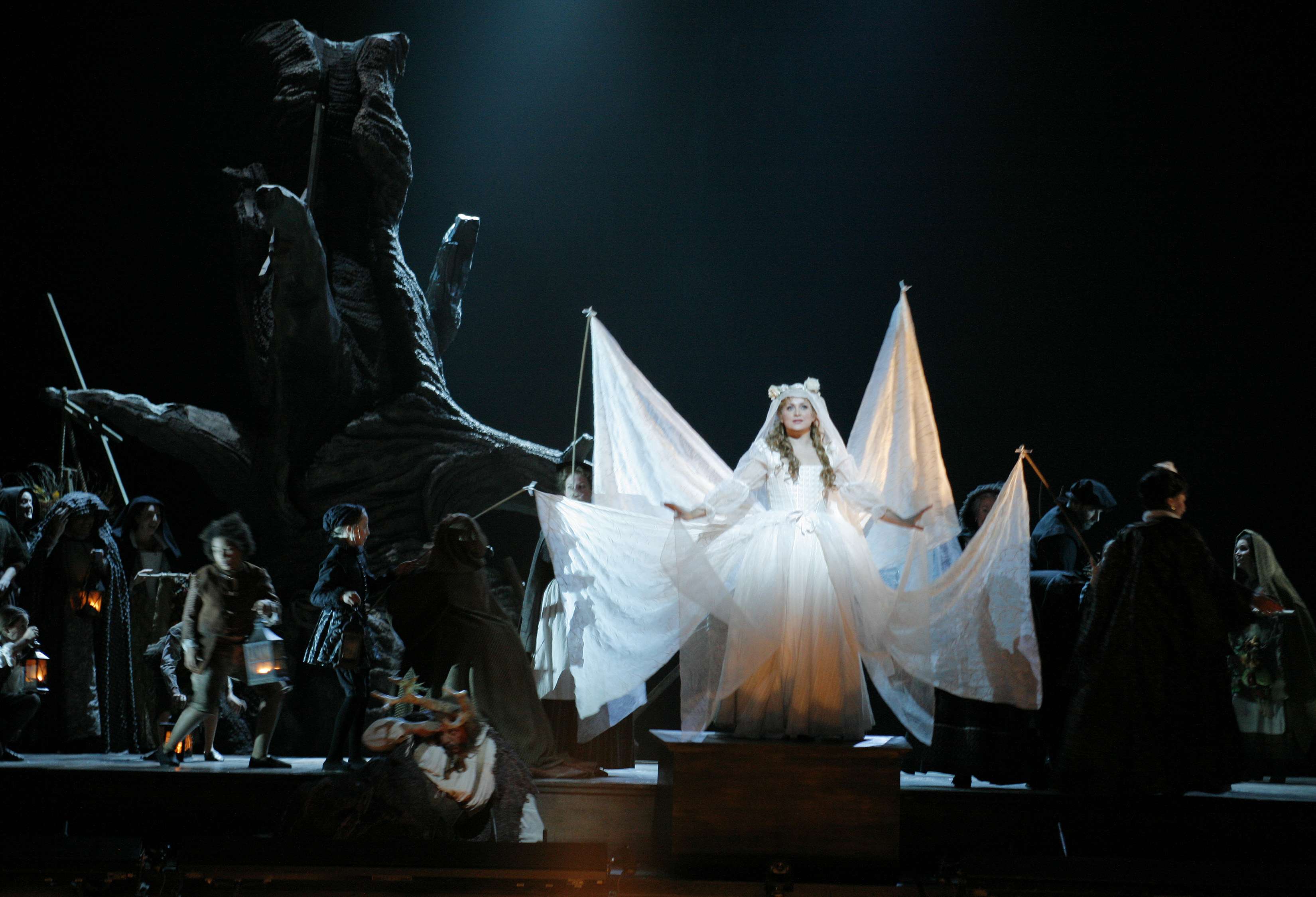|
Back
Once Upon A Falstaff Los Angeles
Dorothy Chandler Pavilion
11/09/2013 - & November 13, 16, 21, 24*, December 1, 2013
Giuseppe Verdi: Falstaff
Robert Brubaker (Dr. Caius), Roberto Frontali (Sir John Falstaff), Rodell Rosel (Bardolph), Valentin Anikin (Pistol), Erica Brookhyser (Meg Page), Carmen Giannattasio (Alice Ford), Ronnita Nicole Miller (Mistress Quickly), Ekaterina Sadovnikova (Nannetta), Juan Francisco Gatell (Fenton), Marco Caria (Ford)
Los Angeles Opera Chorus, Grant Gershon (Chorus Master), Los Angeles Opera Orchestra, James Conlon (Conductor)
Lee Blakeley (Stage Director), Adrian Linford (Scenery and Costume Cesigner), Rick Fisher (Lighting Designer)

E. Sadovnikova (© Robert Millard)
There was once the famous L.A. “Giulini Falstaff” – back in 1982 – a project of the Los Angeles Philharmonic that did much to propel the founding of Los Angeles Opera the following year (though L.A. Opera’s first production was not until 1986).
At the time, accounts of the Giulini Falstaff performances at the Dorothy Chandler Pavilion were politely enthusiastic, these many years later recollections are less so. With the Los Angeles Philharmonic in the pit (called, by the way, the golfo mistico in Italian) a frustrating gulf opened between operatic forces. In opera, the pit is intended as one player in a much larger mechanism, but with this magnificent orchestra in the pit the intention was that singers, scenery, costumes and lights become a part of the symphonic ensemble.
Thus the Giulini stage was simple – a symmetrical and monochromatic country house. And in all other aspects as well the production was understated, and praised because it did not usurp attention. The important pit had become a too formidable gulf to traverse on our way to a real Falstaff.
Falstaff is again at the Dorothy Chandler these 31 or so years later, and it marks a dramatic change of operatic temperament. It is a real Falstaff, a very real one which is to say that there is much to like and much to question. Like why pay good money for a new production that looks like it was a reject for the Giulini Falstaff of thirty years ago.
Once again, the American operatic establishment has looked to the British stage director cabal. In this case, it was one Lee Blakely whose major credits in the program booklet are musicals for Paris’ Théâtre du Châtelet, and some Offenbach and Bizet for Santa Fe Opera. Maybe this explains why the set looked like it had been designed for Santa Fe Opera’s opened-to-the-horizon stage (in Santa Fe they say it is so you can see nature’s magnificent thunderstorms in the distance).
Set symmetrically between identical towers flanking the sides of the stage are the carefully described wooden locales of each of Falstaff’s first two acts, always leaving the horizon line apparent. And for the third act as well, but with a twist. British designer Adrian Linford provides an incongruous weird, nightmarish Black Huntsman’s tree for Windsor Forest begging the question why it is surreal, since in the story it is a real tree (and everything else is real in this production).
Director Blakely did give us a very good third act by envisioning all its magical antics as a parade crossing the horizon between the towers. This trick structured the act very effectively, making the homespun theatrics seem like real homespun theatrics conjured by the residents of Windsor. Maybe the tree needed to be built like a platform so Fenton could find a good place to sing his aria.
There are incongruities in the casting as well. Three singers hold the stage with high operatic panache and voice that is purely Italian. Baritone Roberto Frontali is an accomplished if generic Falstaff and he sings it beautifully and powerfully. Baritone Marco Caria is a handsome Ford who has sufficient voice and presence to anchor the action, an accomplishment all too rare for this role. Soprano Carmen Giannattasio has a bright sound and sparkling persona well suited to a comedic Alice Ford. These are big singers, comfortable doing their thing on the stage.
Then casting became international. Argentine tenor Juan Francisco Gatell makes a fine looking Fenton, his voice with a bright boyish edge rather than a finished tenorial sound. Russian soprano Ekaterina Sadovnikova makes nice sounds and moves as a reserved Nanetta.
The character roles are less effective, most of the singers having neither the personalities nor the experience needed to make their roles vibrant participants in this be-all-and-end-all of ensemble operas. Los Angeles mezzo soprano Ronnita Nicole Miller sang a powerful Erda in the San Francisco Opera Ring but here exhibits little talent as a comedic performer. Rodell Rosel as Bardolfo and Valentin Anikin sing and move well as apprentice artists in roles begging much more.
Tenor Robert Brubaker, a very experienced performer, makes little of Dr. Caius, perhaps due to directorial choices, and that leaves Meg Page, here appropriately accomplished by soprano Erica Brookhyser.
The Los Angeles Opera Orchestra is not the Los Angeles Philharmonic, nor should it be. This ensemble grows in stature with each passing season, and responds well to the demands of its eloquent music director James Conlon. The maestro delivers a lively if unengaging Falstaff, victim of the production. The thrust of the music is oft interrupted by the scene changes requiring some silent and long minutes. A show curtain descends upon which we are offered a lengthy quote from Shakespeare before, finally, the music begins again.
Michael Milenski
|